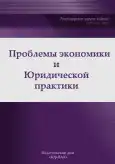On the Dark Side of Reducing Transaction Costs: Development, Efficiency, Communication
- Authors: Kushnir A.M.1,2,3
-
Affiliations:
- Financial University under the Government of the Russian Federation
- A. N. Kosygin Russian State University (Technology. Design. Art)
- Russian University of Transport (RUT-MIIT)
- Issue: Vol 19, No 3 (2023)
- Pages: 127-133
- Section: Economic Theory
- URL: https://journals.eco-vector.com/2541-8025/article/view/568336
- DOI: https://doi.org/10.33693/2541-8025-2023-19-3-127-133
- EDN: https://elibrary.ru/XCYPOC
- ID: 568336
Cite item
Abstract
The purpose of this study is to examine the modern features of transaction costs and their impact on the efficiency of the economy. Based on the analysis of different approaches to the phenomenon of transaction costs the following conclusions were argued in the article. 1. The transition from the Gutenberg galaxy to the Zuckerberg galaxy has led to a decrease in some transaction costs and an increase in other transaction costs. 2. Algorithms of digital platforms significantly predetermine consumer choice. 3. The labor market will be in constant flux. This will lead to a significant increase in switching costs for many professionals. 4. Reduced trust and loyalty to digital technologies is in some measure related to the loss of face-to-face contact. 5. Reduced transaction costs are perceived not only as a boon, but also as: A threat to sustainable everyday practices, a prerequisite for reduced market competition, increased risks and crisis shocks in business and cybersecurity, increased bureaucracy in state institutions and corporations, increased property and information inequalities.
Full Text
About the authors
Andrei M. Kushnir
Financial University under the Government of the Russian Federation; A. N. Kosygin Russian State University (Technology. Design. Art); Russian University of Transport (RUT-MIIT)
Author for correspondence.
Email: Ku7@bk.ru
ORCID iD: 0000-0002-4318-0190
Scopus Author ID: 57219595324
Dr. Sci. (Econ.), Professor; Professor, Department of Mass Communication and Media Business; Professor, Department of Economics and Management; Professor of the Department of Customs Law and Organization of Customs Affairs, Law Institute
Russian Federation, Moscow; Moscow; MoscowReferences
- Vlasov M.V., Veretennikova A.Yu. The content of the modern economic institute // Journal of Economic Theory. 2011. №. 4. pp. 33–45. (in Russian)
- Dianova T. Some features of electronic commerce: from «myths» to the «sliding effect» // Voprosy ekonomiki. 2012. №. 5. pp. 139–146. (in Russian)
- Kalyuzhnova N.Y. Economy of distrust (Institute of trust and its role in the competitiveness of regions) // Regional Economy. 2014. №. 1. pp. 56–65. (in Russian)
- Maracha V.G. Institutions, Reflexion and Trust in the Context of the Question of Social Development Factors // Reflexive Processes and Management. 6. 2006. № 2. pp. 31–40. (in Russian)
- Marichev S. Estimation of the impact of factors reducing the transaction costs of innovation transfer // Economics and Management: a scientific and practical journal. 2022. №. 3. pp. 50–54. (in Russian)
- Nazarova I.B., Dianova T.V. Electronic commerce: advantages, problems and «sliding effect» in reducing transaction costs // Bulletin of MGIMO University. 2012. №. 4. pp. 173–178. (in Russian)
- Pliskevich N.M. Institutional scars in «frontier» societies and the evolution of human potential (part 1: institutional scars) // Voprosy teoreticheskoy ekonomiki. 2022. №. 3. pp. 130–143. (in Russian)
- Sukharev O.S. Structural analysis of technological change and economic growth strategy // Journal of new economy. 2018. 19. №. 3. pp. 26–41. (in Russian)
- Williamson O. Economic Institutions of Capitalism: Firms, Markets, «Relationship» Contracting. SPb.: Lenizdat; CEV Press, 1996. 702 p. (in Russian)
- Shastitko A.E., Tutov L.A. Notes on Methodological Individualism in Economic Research: Are there Borders of Application? Vestnik (Herald) of the Moscow University. Series 6. Economics. 2023. 58(1), pp. 3–21. https://doi.org/10.55959/MSU0130-0105-6-58-1-1 (in Russian).
- Acemoglu D., Robinson J. Non-Modernization: Power–Culture Trajectories and the Dynamics of Political Institutions //Annual Review of Political Science. 2022. 25. pp. 323–339.
- Battilana J. & Lee M. Advancing Research on Hybrid Organizing // Insights from the Study of Social Enterprises. The Academy of Management Annals. 2014. 8:1, pp. 397–441.
- Boymamatovich S. M. Exploring the Benefits and Future of Artificial Intelligence //Central Asian Journal of Theoretical and Applied Science. 2023. 4. №. 3. pp. 108–113.
- Coase R.H. The Nature of the Firm / Economica. 1937. 4: 386-405. https://doi.org/10.1111/j.1468-0335.1937.tb00002.x.
- Commons J.R. Institutional Economics // The American Economic Review. 1931. Vol. 21. No. 4. P. 648–657.№. 9-1. рр. 59–65.
- Dahlman C. J. The problem of externality//Journal Law Econ. 1979. 22. рр. 141–162.
- Grafstein R. Institutional realism: the social and political constraints on rational actors. New Haven and London: Yale University Press, 1992. 244 р.
- Grover V., Malhotra M. K. Transaction cost framework in operations and supply chain management research: theory and measurement //Journal of Operations management. 2003. 21. №. 4. рр. 457–473.
- Kovač M. et al. Institutional development, transaction costs and economic growth: evidence from a cross-country investigation // Journal of Institutional Economics. 2016. V. 12. №. 1. pp. 129–159.
- Kumar H., Gupta P., Chauhan S. Meta-analysis of augmented reality marketing //Marketing Intelligence & Planning. 2023. 41. №. 1. pp. 110–123.
- Peter F. Choice, consent, and the legitimacy of market transactions //Economics & Philosophy. 2004. 20. №. 1. рр. 1–18.
- Petrakis P.E., Valsamis D.G. Entrepreneurship, transaction costs and cultural background //International Business Research. 2013. 6. №. 5. рр. 55–68.
- Pryor F.L. Growth deceleration and transaction costs: a note //Journal of Economic Behavior & Organization. 1994. 25. №. 1. pp. 121–133.
- Ramstad Y. Is a transaction a transaction? // Journal of Economic issues. 1996. 30. №. 2. pp. 413–425.
- Strange R., Humphrey J. What lies between market and hierarchy? Insights from internalization theory and global value chain theory //Journal of International Business Studies. 2019. 50. pp. 1401–1413.
- Wallis J.J., North D. Measuring the transaction sector in the American economy, 1870–1970 // Long-term factors in American economic growth. University of Chicago Press, 1986. рр. 95–162.
Supplementary files











